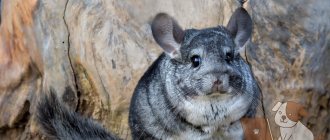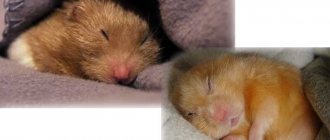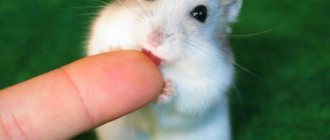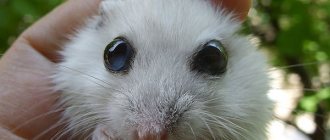Chinchillas are distinguished by excellent health, but in some cases, if the conditions of maintenance and care are violated, the animal may well become ill. What to do if your chinchilla sneezes or coughs, or maybe rubs its nose? It’s worth figuring out what these manifestations are symptoms of and if it’s a cold, start treating it immediately, otherwise death is possible.
If your chinchilla has a cold
The owner of a chinchilla may encounter some diseases of his pet.
Most often, animals get sick due to improper care and nutrition. But sometimes colds also happen. Colds in chinchillas occur at elevated body temperatures. Normal body temperature for a chinchilla is from 36 to 37.8°C, and an increase to 38 is already dangerous for this small animal; 39°C already poses a real threat to its life. To measure a chinchilla's body temperature, you need to lubricate the thermometer with Vaseline and very carefully insert it into the rectum 2-3 cm, try to hold the thermometer for 5 minutes. A chinchilla with a cold may sneeze and will probably develop a fairly severe runny nose. Colds caused by high humidity, cold and drafts are dangerous for chinchilla babies and weakened adults. If a cold is not treated promptly, it develops into a serious and difficult to treat disease. In this case, the sick animal may die.
The most serious complication of a cold is bronchopneumonia. Symptoms of bronchopneumonia: rapid breathing, persistent cough, breathing becomes hoarse and heavy. Dried crusts form in the nasal passages, which interferes with the animal’s normal breathing. The nose may secrete mucus, the chinchilla often sneezes and rubs its nose and mouth with its paws. Behavior becomes nervous and unpredictable. The general condition of the animal is depressed, the pet becomes lethargic and drowsy. With such symptoms, it is necessary to take emergency measures, since there may be little time for a successful cure.
Article on the topic: What to do if a guinea pig’s eye is festering or watery - treatment and symptoms of possible diseases
When the first symptoms of a cold appear, you should create the most comfortable existence for the chinchilla, because a sick animal with a cold needs special care. It is necessary to exclude drafts, additionally insulate the nest, remove dust and improve the quality of food. It is necessary to monitor the temperature and humidity in the room so as not to worsen the animal’s condition with dry and cold air.
Treatment will consist mainly of antibiotics. The veterinarian prescribes injections or tablets that are given to the animal in crushed form. Along with antibiotic treatment, a course of immune medications is prescribed, which must be taken some time after the illness. You need to frequently clean your nose of mucus and crusts. To do this, grasp the chinchilla firmly by the muzzle and clean the nasal passages with a cotton swab previously soaked in chlorhexidine. For a runny nose, you can put baby drops in your chinchilla's nose. But you should carefully calculate the dosage; all drops for the common cold are vasodilators. If you overdose on drops, you will see that the animal begins to stagger when moving, it will become drowsy and noticeably lethargic.
To prevent a chinchilla from getting sick, it is necessary to provide it with proper nutrition, proper care and good living conditions.
Lichen
It also happens that a chinchilla living at home is affected by lichen.
to use special ointments for treatment . But some of them have a strong, unpleasant odor, and there are areas of the animal’s body that are very difficult to reach.
You can use the drug Vaderm . It is sold in almost all pet stores and is quite inexpensive, available in ampoules and administered intramuscularly:
- The injection should be given with an insulin syringe in the thigh, the drug should be injected in 2 divisions, very slowly.
- The animal's thigh is clamped with two fingers, the needle is inserted shallowly so as not to get into the animal's bone.
- It is better to give the injection in the morning, when the activity of chinchillas is reduced.
- After one and a half to two weeks, the vaccination must be done again.
One ampoule is enough for several animals.
After using Vakderm, the chinchilla's immune system is resistant to shingles for one year.
If the injection is done incorrectly , the chinchilla will limp on the pricked paw.
Before using the drug, read the instructions to know, for example, that the medicine is not used for pregnant females .
Ringworm in chinchillas may not be treated at all - after a while this disease goes away.
Chinchillas have a cold
In all recommendations for keeping chinchillas, you will definitely find instructions on where to install the cage. A cage with rodents should not be installed near a window, heating appliances, noise sources, or bright light. It must also be reliably protected from drafts. The fact is that temperature changes provoke the development of colds, which, if left untreated, can lead to serious consequences.
Along with drafts, colds are also provoked by sudden changes in temperature and high humidity. Chinchillas are sensitive to living conditions, and if your pet also has a weakened immune system, then the risk of catching a cold becomes significant. Chinchilla cubs have the hardest time experiencing colds. Therefore, the climate of the room in which children are kept must be monitored even more carefully.
Article on the topic: Diarrhea in a guinea pig: what to do with loose stools?
First of all, a cold is indicated by a runny nose and increased body temperature. The optimal body temperature for a healthy chinchilla is 36-37.8˚ C, and for a sick chinchilla it is 38-39˚ C. An increase in temperature to 38˚ C is already dangerous for a small pet, and higher values pose a threat to life.
Unfortunately, many owners do not consider a cold to be something serious and hope that the illness will go away on its own. But, as practice shows, without timely intervention, even a mild cold can lead to complications, in particular, bronchopneumonia.
Bronchopneumonia is a serious disease accompanied by severe nasal discharge, sneezing, coughing, difficulty and rapid breathing, and wheezing. The behavior of the animal also changes: it rubs its face with its paws, becomes restless, lethargic, and its appetite worsens.
If you suspect bronchopneumonia in your pet, contact your veterinarian as soon as possible: he will prescribe effective medications. Do not self-medicate under any circumstances: in this case, it will only worsen the situation.
If you have cold symptoms, be sure to eliminate drafts, normalize the humidity and air temperature in the room where the chinchilla is kept, improve feeding, and insulate the rodent’s house. Be sure to consult with a specialist; he may prescribe antibiotics and drugs to boost immunity. If your pet has a cold without sudden changes in the indoor climate, reconsider its diet. Perhaps the chinchilla does not receive enough vitamins and nutrients, which negatively affects its immunity. Choose only high-quality, complete and balanced food for your pets.
Take care of your little friends and be healthy!
Rehabilitation period after surgery
Stopping nosebleeds is a kind of surgical intervention, which requires daily observation by an ENT doctor and postoperative rehabilitation. Patients who have had nasal tampons or hemostatic sponges installed receive hemostatic therapy after stopping the bleeding. If necessary, they are transfused with components of lost blood and undergo therapy aimed at lowering blood pressure. On average, a patient stays with a tampon in his nose for 3-7 days. After which the tampons are carefully removed, and the patient is under daily medical supervision for several days. During the rehabilitation period, it is important to continue taking medications that strengthen blood vessels, accelerate healing and moisturize the nasal mucosa.
Colds, sneezing, runny nose and cough in chinchillas: looking for the cause and prescribing treatment
In nature, chinchillas live in the mountains, at an altitude of 400-5000 meters above sea level. These are strong animals, well adapted to cool climates. However, it happens that a chinchilla sneezes, coughs and behaves unusually - you should pay attention to such symptoms and understand the reasons in order to provide timely help to your pet.
Article on the topic: Guinea pig diseases: symptoms and treatment of common diseases
Sneezing, coughing and runny nose in chinchillas
There are several reasons that cause sneezing in chinchillas.
- Allergies to food, dust, litter, indoor plants. Other symptoms include restlessness, itching, hair loss, skin inflammation, and swelling. For treatment, antihistamines are used, and the source of the problem must be removed: clean the cage, change food and filler, put pots with plants away.
- Foreign body: particles of hay, dust, shavings that accidentally entered the nasopharynx. In this case, the chinchilla sneezes incessantly. If, upon examination of the animal, you suspect a foreign body, you should immediately contact a veterinarian and do not try to remove it yourself.
- Stress caused by change of environment or careless handling. The chinchilla shows stress not only by sneezing: it squeaks in fear, trembles or freezes.
- A cold that is often accompanied by a runny nose, cough, fever and lethargy.
A runny nose in animals can be easily distinguished by its characteristic symptoms: discharge of moisture from the nose, accumulation of light mucus in the corners of the eyes, rapid breathing, lethargy. It can be caused by either a cold or dust in the room - in this case, regular cleaning, ventilation and humidification will solve the problem.
Poor quality filler
Why does a chinchilla sneeze? This may be a symptom that you are using the wrong filler in her cage, indoor plants near the cage or food are causing an allergic reaction. What to do in such a situation? Remove the irritant.
If the cause of the ailment is the filler, then you just need to replace it. Choose a filler from environmentally friendly materials, as these animals are very sensitive and can react to any irritant. Wood pellets and sawdust are excellent choices. You may also need to take antihistamines.
Reference. If you take sawdust from private production, please note that the wood should not be treated with any substances.
Cough as a symptom
Cough in rodents comes from different origins:
- allergies;
- cardiovascular failure: in addition to coughing, accompanied by shortness of breath, wheezing;
- colds, including severe forms such as tracheitis, bronchitis, pneumonia;
- foreign body in the throat: in this case, there is a urge to vomit and attempts to cough up. You need to try to shake out the stuck object by turning the animal upside down, and if you can’t help, immediately seek help.
Attention! Understanding the symptoms of diseases is useful, but only a veterinarian can accurately diagnose and treat the disease.
Foreign body in the nose
An animal can also sneeze if a foreign body gets into its nose. When eating, particles of food or hay may well enter the nasopharynx, which will cause a reflex sneezing.
If the animal does not stop sneezing and behaves restlessly, it is necessary to immediately show it to a specialist to provide first aid in such a situation. You should not help your animal remove a foreign object on your own.
Chinchillas have a cold
These animals, native to the South American Andes, are quite resistant to colds, but in the wrong conditions they can get sick. Drafts, room temperatures below +15 degrees, high air humidity and infections are especially dangerous.
Article on the topic: Guinea pig does not eat or drink, what should I do? Reasons for refusing to eat.
How can you tell if your pet has a cold?
- the animal rubs its nose, sneezes, coughs;
- body temperature rises: normally 36 – 37.5 ° C, measurements are carried out rectally;
- clear or cloudy fluid is discharged from the nose;
- white or yellowish mucus in the corners of the eyes;
- activity decreases, the animal is sleepy and lethargic;
- rapid breathing.
We treat the disease
A chinchilla begins to sneeze when it has a cold or other respiratory diseases. A cold is the most common cause of sneezing; the animal rubs its nose and is rather lethargic and refuses food.
A runny nose is quite easy to recognize. It manifests itself:
- Pet's wet nostrils.
- Discharge of mucous snot in the nose.
- White or yellow mucus accumulates in the corners of the eyes.
- The animal is lethargic and drowsy.
- Rapid breathing.
Treatment should be entrusted to a specialist, since your incorrect actions can lead to the development of more serious diseases or even death of the pet.
Interestingly, a pet can easily become infected from a person. Any diseases that are transmitted by airborne droplets can be transmitted from owner to pet. For this reason, try to minimize interaction with the pet of sick family members. During the period of illness, try to ventilate the room more often, clean the cage using a protective mask, and increase the frequency of wet cleaning.
Reference. These rodents have an increased metabolism, for this reason any diseases develop in them very quickly, which ultimately can lead to dire consequences. Be attentive to your pet.
What to do if your chinchilla has a cold?
In chinchillas, diseases progress quickly, so you should not postpone a visit to the veterinary clinic and treat yourself.
To prevent the animal from infecting its relatives, it is isolated in a separate cage. Make sure there are no drafts nearby, it is better to cover the cage with fabric for extra warmth. It is also advised to frequently wet clean the room and maintain air humidity within 50-60%.
Depending on the condition of the animal, the doctor prescribes antibacterial and anti-inflammatory treatment. Chinchillas are often given a decoction of rose hips or chamomile, pouring them instead of water into the drinking bowl. The eyes are wiped of discharge for the first 2-3 days using a 2% solution of boric acid.
A nutritious diet containing plenty of vitamin C will help speed up recovery.
Attention! If a chinchilla's body temperature rises to 38 °C, it is immediately knocked down, and a temperature of 39 °C is considered life-threatening.
Slobber
Drool is a dental disease.
Chinchillas have two types of this disease:
- when the animal has sharp edges of its molars;
- improperly grown incisors.
The cause of the disease is usually improper jaw structure. Over time, the sharp edges of the teeth begin to injure the inner cavity of the mouth, and salivation increases - saliva flows down the corners of the mouth.
Both pathologies are usually detected in the third year of life of animals, and can be inherited.
- If the disease is advanced , the animal always has a wet neck, chest and front paws.
The same symptoms appear when the incisors grow incorrectly. As a result, the animal’s mouth may not close at all, and the teeth will injure the gums. - To avoid this, you need to cut off the sharp edges of the molars with a drill , break them off and grind them with a tool. The operation is performed only under anesthesia. This can extend the animal's life by six months. Afterwards the edges will grow again.
- If the growth of the incisors is impaired , they can be trimmed with pliers. But this will only save the animal for a few months. The teeth will no longer grow normally, and it is likely that the animal will die from exhaustion.
Other reasons
If a chinchilla is sneezing, it is necessary to establish the cause as quickly as possible, as it can be more serious than an ordinary runny nose.
Respiratory diseases
The common cold, if treatment is not carried out or is ineffective, gives complications to the respiratory system:
- tracheitis;
- bronchitis;
- bronchopneumonia;
- pneumonia .
Often they are caused by a secondary infection - bacteria Staphylococcus, Pasteurella, Streptococcus. Respiratory diseases are dangerous for both puppies and adult animals: lack of treatment can lead to the death of the animal, so it is important to immediately contact a veterinarian. Antibiotics are used in therapy, including those administered intramuscularly.
Article on the topic: Pododermatitis in guinea pigs (corns, calluses): causes and treatment
Symptoms of bronchopneumonia are:
- frequent cough;
- wheezing, heavy breathing;
- heat;
- apathy.
An accurate diagnosis is made by a veterinarian. In such cases, chinchillas are usually prescribed the antibiotic Biomycin and expectorants. Be sure to keep the sick animal warm and avoid drafts.
Newborn babies often suffer from pneumonia, especially in the autumn-winter period. The disease is mainly caused by a secondary infection - staphylococcus or streptococcus. It has similar symptoms to bronchopneumonia.
Treatment requires a broad-spectrum antibiotic; Baytril is most often prescribed. At the same time, the chinchilla is given the probiotic “Lactobacterin” or “Vetom”, which is diluted with water in a 1:1 ratio. Additionally, the vitamin complex “Gamavit” is injected under the skin, 1 cube per day for the first three days.
Under unfavorable conditions, chinchillas may develop pulmonary hyperemia: this means that the vessels of the animal’s lungs become overfilled with blood. Most often this happens in hot, stuffy rooms or when inhaling toxic substances. Symptoms of flushing include:
- hoarse cough;
- shortness of breath;
- attacks of suffocation;
- rapid pulse;
- reddish foamy discharge from the nose.
First of all, it is necessary to place the animal in an optimal environment, and then carry out treatment depending on the cause of the condition. In case of overheating, pouring cool water, cardiac drops with caffeine, and diuretics helps. In case of complications, antibacterial agents may also be needed.
Stress in chinchillas
Sneezing in chinchillas can also be caused by stress. This is indicated by such signs as trembling, a plaintive cry, squeaking, restless behavior or, conversely, numbness.
Stress in an animal can be triggered by various events:
- change of environment;
- transportation in transport;
- falls and injuries;
- placing chinchillas in one cage;
- contact with larger animals;
- careless handling;
- attention of strangers.
First, eliminate the cause of the stress, then try to calm your pet. To do this, you can feed him his favorite food, try to distract him, or play with him. If the animal is still nervous, give it the opportunity to be in a quiet environment, cover the cage with a dark cloth. In such cases, mint leaves help: they are safe for animals and act as a sedative.
Article on the topic: A guinea pig has lost its hind legs: causes and treatment
First aid for nosebleeds
- Call an ambulance or see an ENT doctor at the nearest clinic.
- Place the patient in a sitting position. Throwing your head back or lying down is undesirable. It is better to take a vertical position, placing a tray under your chin to determine the volume of lost blood.
- If the patient suffers from hypertension, measure blood pressure and take blood pressure-lowering medications prescribed by the doctor.
- Apply cold to the nose area and apply a cold towel to the collar area.
- Moisten cotton wool with 3% hydrogen peroxide and place it in the vestibule of the nose.
- Press the wing of the nose against the septum for 10-15 minutes.
Can a chinchilla catch a cold from a person?
Furry rodents are susceptible to many of the same respiratory infections that affect humans. Therefore, during the season of increased morbidity, you need to carefully observe hygiene: wash your hands, change street clothes before contacting your pet. It is recommended to frequently ventilate the room and do wet cleaning.
If the owner gets sick, he will have to minimize contact with the pets and carry out all manipulations in the cage wearing a medical mask.
The chinchilla is a small animal, and therefore requires close attention in order to notice the disease in time. A good owner cares about the health of his pet, but even proper care does not always save him from problems. If your animal does get sick, do not put off visiting the doctor and do not treat it yourself.
Sources:
https://pets.academ.info/5270 https://hvost.news/animals/rodents-health/prostuda-u-shinshill/ https://homjakam.ru/shinshilla/zdorovie/shinshilla-chihaet











